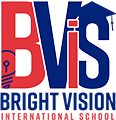Vision
Mission

Child Protection Policy
Bright Vision International School commitmeted to safeguarding and promoting the welfare of all it’s student. Child protection is everyone's responsibility, for a safe, secure, and nurturing environment where children can learn and thrive.

Policy Aims & Objectives ( prevision, protection and support )
✔ To ensure all staff are trained to recognize and respond to child protection concerns.
✔ To provide clear procedures for reporting and managing concerns.
✔ To support children who have been, or are at risk of, abuse.
Legal Framework
▶ International: UN Convention on the Rights of the Child (UNCRC).
▶ Egyptian: Egyptian Child Law No. 12 of 1996 and its amendments (Law No. 126 of 2008,etc.).
Any act causing injury, trauma, or other physical suffering or bodily harm.
Indicators: Unexplained bruises, welts, burns (especially with clear shapes of objects),fractures, frequent injuries “explained” as accidents, child flinching at sudden movements, reluctance to change for PE, etc.
Designated Safeguarding Lead (DSL):
– Primary point of contact for all child protection concerns.
– Manages referrals to external agencies.
– Keeps detailed, secure records.
– Ensures staff training.
– Liaises with Head of School and Board.
– enforce child protection across the school.
All Staff:
– Mandatory duty to read, understand, and adhere to the policy.
– Be vigilant for signs of abuse.
– Report ANY concern immediately to the DSL, no matter how small.
– Maintain professional boundaries.
– Contribute to a safe school culture.
– Maintain Professional Boundaries: Avoid favouritism, inappropriate personal relationships, sharing personal problems with students.
– Communication: Use school-approved channels, be professional in tone and content.
– Physical Contact: Generally, avoid unless necessary for safety (e.g., preventing a fall) or providing comfort in a very public and age-appropriate way (e.g., a brief side-hug for a distressed young child, if culturally appropriate and school-sanctioned).
– One-to-One Situations: Avoid being alone with a child in a closed room where you cannot be seen. If necessary, ensure a door is open, another adult is aware, or it’s visible to others.
– Photography/Video: Only use school equipment. Obtain parental consent. Store images securely. Be mindful of context (e.g., no swimwear photos unless for specific sporting achievement and with consent).
Responding to Disclosure:
⏺ Listen carefully, do not interrupt unless necessary.
⏺ Reassure the child they did the right thing by telling.
⏺ Do NOT promise confidentiality (“I can’t keep this a secret, but I will only tell people who need to know to help you”).
⏺ Do NOT ask leading questions.
⏺Do NOT investigate yourself.
⏺ Record verbatim what the child said as soon as possible (use the Concern Reporting Form).
– Interview Questions: Include scenario-based questions about safeguarding dilemmas. “What
would you do if…?”
– Criminal Record Checks: for all individuals working with children (e.g., “Sahifat al-Ahwal
al-Ginaiyya” – certificate of good conduct).
– Activated Policies for staff and students review by the school board.
– Implementation of Monitoring systems.
– Curriculum activities and opportunities, which equip students with the skills they need to stay safe from abuse.

